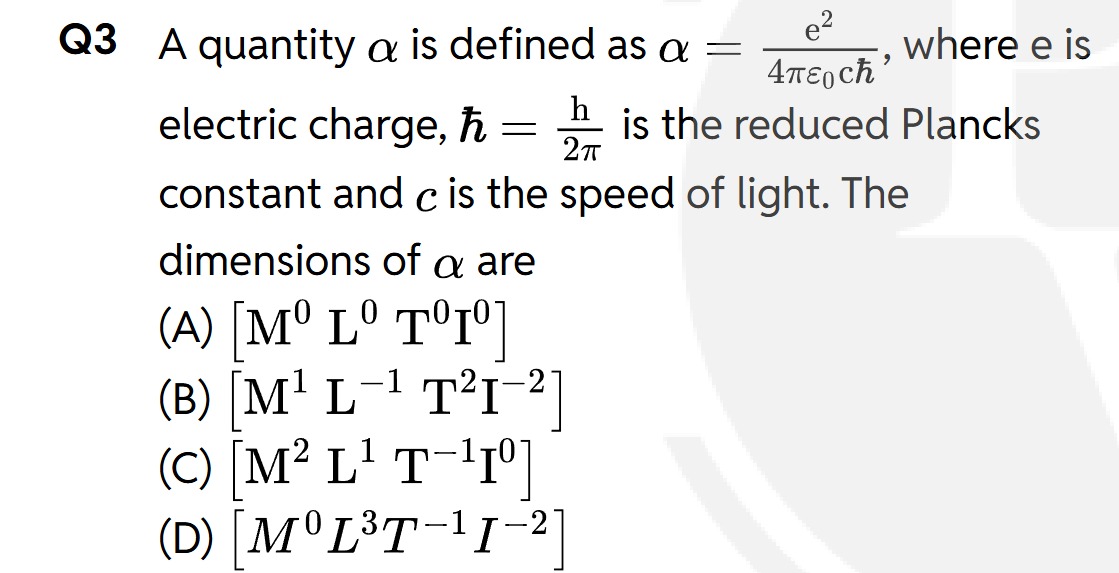Question
Question: A quantity $\alpha$ is defined as $\alpha = \frac{e^2}{4\pi\epsilon_0 c\hbar}$, where e is electric ...
A quantity α is defined as α=4πϵ0cℏe2, where e is electric charge, ℏ=2πh is the reduced Plancks constant and c is the speed of light. The dimensions of α are

[M0L0T0I0]
[M1L−1T2I−2]
[M2L1T−1I0]
[M0L3T−1I−2]
[M^0 L^0 T^0 I^0]
Solution
To find the dimensions of the quantity α=4πϵ0cℏe2, we need to determine the dimensions of each component in the expression. The constant 4π is dimensionless.
The dimensions of the components are:
- Electric charge e: [e]=[IT], where I represents electric current and T represents time.
- Speed of light c: [c]=[LT−1], where L represents length.
- Reduced Planck's constant ℏ: Planck's constant h has the dimensions of energy multiplied by time (action). The dimension of energy is [ML2T−2] (from E=21mv2). So, [h]=[ML2T−2]×[T]=[ML2T−1]. Since ℏ=2πh and 2π is dimensionless, [ℏ]=[ML2T−1].
- Permittivity of free space ϵ0: We can find the dimensions of ϵ0 from Coulomb's Law, F=4πϵ01r2q1q2. Rearranging for ϵ0, we get ϵ0=4πFr2q1q2. The dimension of force F is [MLT−2]. The dimensions of charges q1 and q2 are [IT]. The dimension of distance r is [L]. So, [ϵ0]=[MLT−2][L2][IT][IT]=[ML3T−2][I2T2]=[M−1L−3T4I2].
Now, substitute these dimensions into the expression for α: [α]=[ϵ0][c][ℏ][e2] [e2]=([IT])2=[I2T2]
Denominator dimensions = [ϵ0][c][ℏ] =[M−1L−3T4I2]×[LT−1]×[ML2T−1] Combine the powers of each fundamental dimension: M: M−1×M1=M−1+1=M0 L: L−3×L1×L2=L−3+1+2=L0 T: T4×T−1×T−1=T4−1−1=T2 I: I2 So, the dimensions of the denominator are [M0L0T2I2].
Now, calculate the dimensions of α: [α]=[M0L0T2I2][I2T2] Combine the powers of each fundamental dimension: M: M0/M0=M0−0=M0 L: L0/L0=L0−0=L0 T: T2/T2=T2−2=T0 I: I2/I2=I2−2=I0
Thus, the dimensions of α are [M0L0T0I0]. This quantity α is the fine-structure constant, which is a dimensionless fundamental constant.
